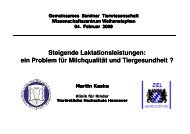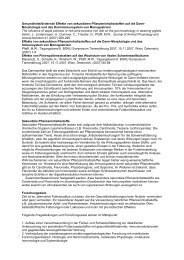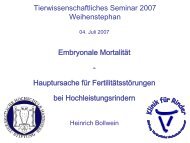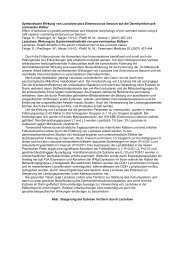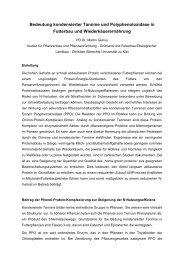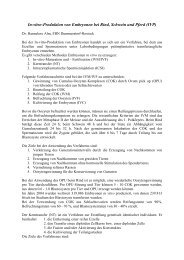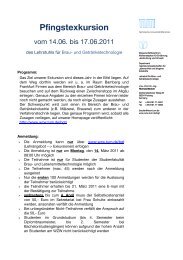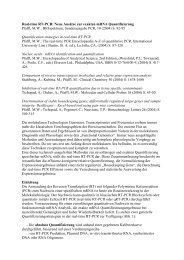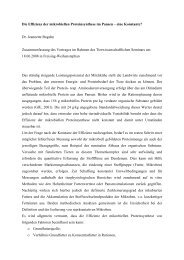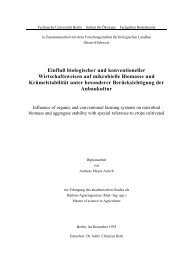Two-Dimensional Electrophoresis with Immobilized pH Gradients for ...
Two-Dimensional Electrophoresis with Immobilized pH Gradients for ...
Two-Dimensional Electrophoresis with Immobilized pH Gradients for ...
Create successful ePaper yourself
Turn your PDF publications into a flip-book with our unique Google optimized e-Paper software.
- 7 -<br />
are usually added, but they may modify proteins and cause charge artifacts. Other<br />
remedies are boiling the sample in SDS-buffer (<strong>with</strong>out urea!), or inactivating proteases<br />
by low <strong>pH</strong> (e.g., precipitating <strong>with</strong> ice-cold trichloroacetic acid (TCA)). However, it should<br />
be kept in mind that it may be rather difficult to completely inactivate all proteases.<br />
TCA/acetone precipitation is very useful <strong>for</strong> (i) minimizing protein degradation, <strong>for</strong> (ii)<br />
removing interfering compounds, such as salt, or polyphenols, and (iii) <strong>for</strong> the enrichment<br />
of very alkaline proteins such as ribosomal proteins from total cell lysates (Görg et al.<br />
1999). Attention has to be paid, however, to protein losses due to incomplete precipitation<br />
and/or resolubilization of proteins. Moreover, a completely different set of proteins may be<br />
obtained by extraction <strong>with</strong> lysis buffer depending on whether or not there was a<br />
preceding TCA precipitation step. On the other hand, this effect can be used <strong>for</strong> the<br />
enrichment of very alkaline proteins (such as ribosomal or nuclear proteins) from total cell<br />
lysates (Görg et al. 1999, 2000).<br />
Salt ions may interfere <strong>with</strong> electrophoretic separation and should be removed if their<br />
concentration is too high (>100 mM); otherwise proteins may precipitate at the site of<br />
sample application, giving rise to horizontal and/or vertical streaks. Salt also increases<br />
the conductivity of the IEF gel, thereby prolonging the time required to reach the steadystate.<br />
In extreme cases, IEF may virtually stop due to salt fronts. Salt removal can be<br />
achieved by (spin)dialysis, or precipitation of proteins <strong>with</strong> TCA or organic solvents (e.g.,<br />
cold acetone). One alternative is the use of 2-D clean-up kits (e.g., GE Healthcare<br />
Lifesciences). Another is dilution of the sample below a critical salt concentration followed<br />
by application of a larger sample volume onto the IPG gel. The sample is “desalted” in the<br />
gel by applying low voltages (100 V) at the beginning of the run <strong>for</strong> up to several hours<br />
and replacing the filter paper pads beneath the electrodes (where the salt ions have<br />
collected) several times (Görg et al., 2000)<br />
High amounts of lipids may interact <strong>with</strong> membrane proteins and “consume“ detergents.<br />
Delipidation of lipid-rich biological material (e.g., brain tissues) can be accomplished by<br />
extraction <strong>with</strong> organic solvents (e.g., cold ethanol or acetone). However, severe losses in<br />
proteins may be experienced, either because certain proteins are soluble in organic<br />
solvent, or because the precipitated proteins do not always resolubilize. Alternatively,<br />
high-speed centrifugation and subsequent removal of the lipid-layer has been<br />
recommended.<br />
Polysaccarides (especially the charged ones) and nucleic acids can interact <strong>with</strong> carrier<br />
ampholytes and proteins, and give rise to streaky 2-D patterns. Moreover, these<br />
macromolecules may also increase the viscosity of the solutions and clog the pores of the<br />
polyacrylamide gels. Unless present at low concentrations, polysaccharides and nucleic<br />
acids have to be removed. A common method is precipitation of proteins <strong>with</strong><br />
TCA/acetone, but losses in proteins may be experienced due to unsufficient<br />
resolubilization of proteins. Other recommendations <strong>for</strong> the removal of nucleic acids are



